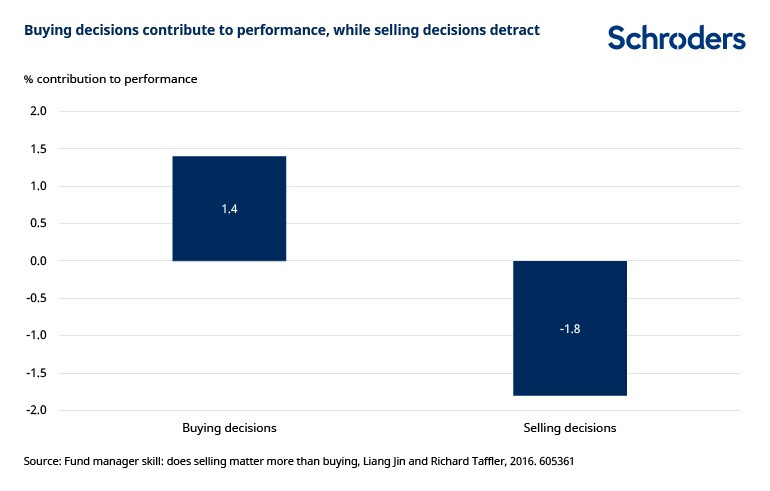Why most investors are bad at selling and what they can do about it
Poor selling decisions lead to underwhelming investment performance. We identify four biases that explain why selling is so much harder than buying, and offer potential remedies

Authors
Benjamin Graham, the father of value investing, had it right when he said over 70 years ago: “The worst enemy of the investor is most likely himself”.
A wealth of research since then has taught us how human decision-making is beset with frequent and persistent behavioural biases, leading to poor financial decision-making. This is true for professional and hobby investors alike.
Active managers have a patchy track record
Active investors on aggregate have persistently shown poor performance. If there was ever time for them to shine and exploit investment inefficiencies, the volatility of the Covid pandemic was it. But the evidence is disappointing.
Case in point: an analysis by the Financial Times shows that only about one in four professional portfolio managers investing in the US managed to beat the S&P 500, the most widely-followed equity market index, in 2021.
But is this down to their buying or their selling? If we decompose the aggregate investment results by professional money managers into how much is attributed to their buying decisions compared to their selling decisions, the results are astounding.
In a landmark paper, Professors Jin and Taffler (2016) looked at a large sample of over 3000 fund managers over the period spanning from 2003 to 2013. They found that on aggregate buying decisions added 1.4% of outperformance per year, while selling decisions detracted -1.8% annually in underperformance.
This demonstrates that the majority of fund managers do actually have a persistent skill in selecting investment opportunities that outperform following the buy decision. However, aggregate results are poor because investors managed to lose staggering amounts of money with their ill-timed selling decisions.

Given the size of the problem, surprisingly little attention is given to this shortcoming.
The human brain is not evolved for financial decision-making
Modern brain neurology has shown that the emotion of fear is processed very differently in the brain from the opposite feeling of exuberance because it is processed in a different location. As a result, humans think of (financial) losses very differently to how they think about gains, leading to suboptimal decision-making.
Bias 1: Loss aversion, or the risk of focusing on the recent past
This leads us to our first bias, which sees investors fall victim to “myopic loss aversion”. This is the tendency to allow very recent performance history to shape one’s risk assessment of an investment.
If an investment has recently declined in value and is now carried at a loss, this loss triggers a fear response in the investor’s brain, which in turn leads them to conclude that the investment is much riskier than a comparable investment carried at a gain. This natural fear of realising a loss leads most fund managers to hold onto a losing position much longer than is rationally warranted.
A potential remedy to this bias could be an institutionalised framework for automatically reviewing money-losing positions, with an explicit emphasis on the future investment prospects.
Bias 2: Availability bias, or preference for easy solutions
The human brain has developed mechanisms to reduce a highly complex world into easy decisions. One example is the “availability bias,” which states that in complex decision making we do not consider all alternatives equally but quickly jump to the ones which come to mind first.
Professors Jin and Taffler (2016) have illustrated this point by separating all portfolio manager decisions into two categories: first, those motivated by new money inflows or outflows (liquidity events); and second, those driven by relative risk/reward assessments. The results were astonishing: when dealing with liquidity events, fund managers’ selling decisions were particularly poor.
As a piece of advice on how to improve their performance, investors should always ask themselves the same question regardless of what the motivation for selling: which stock in my portfolio has the worst risk/reward in the period to come?
Bias 3: Confirmation bias, or the dangers of overoptimism
A good dose of human optimism is valuable in many aspects of life. But not when it comes to rational decision-making.
Our innate tendency to believe that we are right clouds our thinking in important ways. Once we have made an investment decision, we have bought into its merits and are committed to it. Unfortunately, this means that we have a strong bias to interpret subsequent data points in a way to appear favourable to our original premise. This “confirmation bias” makes it highly likely that we will miss important information that runs counter to our beliefs.
To try to overcome confirmation bias, it can be helpful to task a neutral observer with picking up negative data points. Or engage in a “pre-mortem”, an analysis explicitly focused on what data would look like should things go wrong.
Bias 4: Spending more time on buying decisions than selling
A widely cited academic publication by Akepanidtaworn et al (2018) adds to our understanding of why professional investors are bad at selling stocks. Their analysis separates sell decisions into days when fundamental news (such as earnings announcements) was published and days without relevant financial news.
Interestingly, when acting on fundamental financial news, sell decisions improved substantially and contributed positively to overall results (by about 1% per year). However, when selling investments on quiet days, the results were extremely negative (reducing results by -2% annually).
Conversely, the impact of buying decisions was virtually identical regardless of which days the trades occurred on. The obvious lesson from this study is to only sell based on fundamental reasons.
There are multiple reasons which might distract fund managers and lead them to sell based on other criteria.
For example, countless hours go into the buy analysis including writing lengthy reports, extensive quantitative modelling and intense team discussions. On the flipside, the determination to sell often happens much faster.
As a process improvement, investors should shift a more meaningful portion of their time budget towards sell decisions.
A final major difference between buying and selling is that portfolio managers usually employ elaborate quantitative tools decomposing the performance attribution of each of their holdings. As such, they tend to be keenly aware of how much their investments have contributed to total performance. However, as soon as an investment is sold it usually ceases to be tracked.
It is hard to learn about the success of your selling decisions if you stop measuring their performance attributes. The remedy to this shortcoming is obvious: set up a measurement tool analysing the timing of each sell decision.
Cognitive biases affect all realms of life
While this article has focused on decision-making in the financial industry, its conclusions and lessons can be equally applied to many aspects of everyday life.
For example, an unhappy engineer might be unwilling to change careers because of the countless hours of training already they have already invested. This might be a very similar thought process in a fund manager who refuses to sell a fallen investment because of loss aversion. In both instances, the individual refuses to face up to the fact that a mistake has occurred in the past (known as the sunk cost fallacy).
In an effort to save face, we try to convince ourselves that, by waiting, things will improve. But rarely do mistakes fix themselves while we’re looking the other way.
Authors
Topics